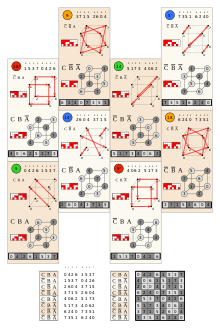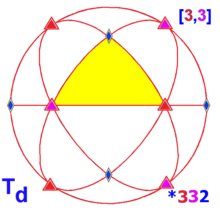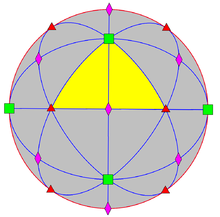 The C2 group has order 8 as shown on this circle |
 The C3 (Oh) group has order 48 as shown by these spherical triangle reflection domains. |
A hyperoctahedral group is a type of mathematical group that arises as the group of symmetries of a hypercube or of a cross-polytope. It was named by Alfred Young in 1930. Groups of this type are identified by a parameter n, the dimension of the hypercube.
As a Coxeter group it is of type Bn = Cn, and as a Weyl group it is associated to the symplectic groups and with the orthogonal groups in odd dimensions. As a wreath product it is where Sn is the symmetric group of degree n. As a permutation group, the group is the signed symmetric group of permutations π either of the set or of the set such that for all i. As a matrix group, it can be described as the group of n × n orthogonal matrices whose entries are all integers. Equivalently, this is the set of n × n matrices with entries only 0, 1, or –1, which are invertible, and which have exactly one non-zero entry in each row or column. The representation theory of the hyperoctahedral group was described by (Young 1930) according to (Kerber 1971, p. 2).
In three dimensions, the hyperoctahedral group is known as O × S2 where O ≅ S4 is the octahedral group, and S2 is a symmetric group (here a cyclic group) of order 2. Geometric figures in three dimensions with this symmetry group are said to have octahedral symmetry, named after the regular octahedron, or 3-orthoplex. In 4-dimensions it is called a hexadecachoric symmetry, after the regular 16-cell, or 4-orthoplex. In two dimensions, the hyperoctahedral group structure is the abstract dihedral group of order eight, describing the symmetry of a square, or 2-orthoplex.
By dimension


Hyperoctahedral groups can be named as Bn, a bracket notation, or as a Coxeter group graph:
| n | Symmetry group |
Bn | Coxeter notation | Order | Mirrors | Structure | Related regular polytopes | |
|---|---|---|---|---|---|---|---|---|
| 2 | D4 (*4•) | B2 | 22! = 8 | 4 | Square, octagon | |||
| 3 | Oh (*432) | B3 | 23! = 48 | 3+6 | Cube, octahedron | |||
| 4 | ±/6.2 (O/V;O/V) |
B4 | 24! = 384 | 4+12 | Tesseract, 16-cell, 24-cell | |||
| 5 | B5 | 25! = 3840 | 5+20 | 5-cube, 5-orthoplex | ||||
| 6 | B6 | 26! = 46080 | 6+30 | 6-cube, 6-orthoplex | ||||
| ...n | Bn | 2n! = (2n)!! | n | hypercube, orthoplex | ||||
Subgroups
There is a notable index two subgroup, corresponding to the Coxeter group Dn and the symmetries of the demihypercube. Viewed as a wreath product, there are two natural maps from the hyperoctahedral group to the cyclic group of order 2: one map coming from "multiply the signs of all the elements" (in the n copies of ), and one map coming from the parity of the permutation. Multiplying these together yields a third map . The kernel of the first map is the Coxeter group In terms of signed permutations, thought of as matrices, this third map is simply the determinant, while the first two correspond to "multiplying the non-zero entries" and "parity of the underlying (unsigned) permutation", which are not generally meaningful for matrices, but are in the case due to the coincidence with a wreath product.
The kernels of these three maps are all three index two subgroups of the hyperoctahedral group, as discussed in H1: Abelianization below, and their intersection is the derived subgroup, of index 4 (quotient the Klein 4-group), which corresponds to the rotational symmetries of the demihypercube.
In the other direction, the center is the subgroup of scalar matrices, {±1}; geometrically, quotienting out by this corresponds to passing to the projective orthogonal group.
In dimension 2 these groups completely describe the hyperoctahedral group, which is the dihedral group Dih4 of order 8, and is an extension 2.V (of the 4-group by a cyclic group of order 2). In general, passing to the subquotient (derived subgroup, mod center) is the symmetry group of the projective demihypercube.

The hyperoctahedral subgroup, Dn by dimension:
| n | Symmetry group |
Dn | Coxeter notation | Order | Mirrors | Related polytopes | |
|---|---|---|---|---|---|---|---|
| 2 | D2 (*2•) | D2 | = × | 4 | 2 | Rectangle | |
| 3 | Td (*332) | D3 | 24 | 6 | tetrahedron | ||
| 4 | ±/3.2 (T/V;T/V)− |
D4 | 192 | 12 | 16-cell | ||
| 5 | D5 | 1920 | 20 | 5-demicube | |||
| 6 | D6 | 23040 | 30 | 6-demicube | |||
| ...n | Dn | 2n! | n(n-1) | demihypercube | |||


The chiral hyper-octahedral symmetry, is the direct subgroup, index 2 of hyper-octahedral symmetry.
| n | Symmetry group |
Coxeter notation | Order | |
|---|---|---|---|---|
| 2 | C4 (4•) | 4 | ||
| 3 | O (432) | 24 | ||
| 4 | /6.2 (O/V;O/V) |
192 | ||
| 5 | 1920 | |||
| 6 | 23040 | |||
| ...n | 2n! | |||
Another notable index 2 subgroup can be called hyper-pyritohedral symmetry, by dimension: These groups have n orthogonal mirrors in n-dimensions.
| n | Symmetry group |
Coxeter notation | Order | Mirrors | Related polytopes | |
|---|---|---|---|---|---|---|
| 2 | D2 (*2•) | = | 4 | 2 | Rectangle | |
| 3 | Th (3*2) | 24 | 3 | snub octahedron | ||
| 4 | ±/3.2 (T/V;T/V) |
192 | 4 | snub 24-cell | ||
| 5 | 1920 | 5 | ||||
| 6 | 23040 | 6 | ||||
| ...n | 2n! | n | ||||
Homology
The group homology of the hyperoctahedral group is similar to that of the symmetric group, and exhibits stabilization, in the sense of stable homotopy theory.
H1: abelianization
The first homology group, which agrees with the abelianization, stabilizes at the Klein four-group, and is given by:
This is easily seen directly: the elements are order 2 (which is non-empty for ), and all conjugate, as are the transpositions in (which is non-empty for ), and these are two separate classes. These elements generate the group, so the only non-trivial abelianizations are to 2-groups, and either of these classes can be sent independently to as they are two separate classes. The maps are explicitly given as "the product of the signs of all the elements" (in the n copies of ), and the sign of the permutation. Multiplying these together yields a third non-trivial map (the determinant of the matrix, which sends both these classes to ), and together with the trivial map these form the 4-group.
H2: Schur multipliers
The second homology groups, known classically as the Schur multipliers, were computed in (Ihara & Yokonuma 1965).
They are:
Notes
- ^ Conway & Smith 2003
- du Val 1964, #47
- du Val 1964, #42
- du Val 1964, #27
- Coxeter 1999, p. 121, Essay 5 Regular skew polyhedra
- du Val 1964, #41
References
- Miller, G. A. (1918). "Groups formed by special matrices". Bull. Am. Math. Soc. 24 (4): 203–6. doi:10.1090/S0002-9904-1918-03043-7.
- du Val, P. (1964). Homographies, Quaternions and Rotations. Oxford mathematical monographs. Clarendon Press. OCLC 904102141.
- Ihara, Shin-ichiro; Yokonuma, Takeo (1965), "On the second cohomology groups (Schur-multipliers) of finite reflection groups", Journal of the Faculty of Science. University of Tokyo. Section IA. Mathematics, 11: 155–171, ISSN 0040-8980, MR 0190232
- Kerber, Adalbert (1971), Representations of permutation groups. I, Lecture Notes in Mathematics, vol. 240, Springer-Verlag, doi:10.1007/BFb0067943, ISBN 978-3-540-05693-5, MR 0325752
- Kerber, Adalbert (1975), Representations of permutation groups. II, Lecture Notes in Mathematics, vol. 495, Springer-Verlag, doi:10.1007/BFb0085740, ISBN 978-3-540-07535-6, MR 0409624
- Young, Alfred (1930), "On Quantitative Substitutional Analysis 5", Proceedings of the London Mathematical Society, Series 2, 31: 273–288, doi:10.1112/plms/s2-31.1.273, ISSN 0024-6115, JFM 56.0135.02
- Coxeter, H.S.M.; Moser, W.O.J. (2013) . Generators and Relations for Discrete Groups (4th ed.). Springer. p. 92 §7.4 Linear fractional groups, p. 122 §9.3 Finite Groups. ISBN 978-3-662-21943-0.
- Baake, M. (1984). "Structure and representations of the hyperoctahedral group". J. Math. Phys. 25 (11): 3171. Bibcode:1984JMP....25.3171B. doi:10.1063/1.526087.
- Stembridge, John R. (1992). "The projective representations of the hyperoctahedral group". J. Algebra. 145 (2): 396–453. doi:10.1016/0021-8693(92)90110-8. hdl:2027.42/30235.
- Coxeter, H.S.M. (1999). The Beauty of Geometry: Twelve Essays. Dover. ISBN 0-486-40919-8. LCCN 99035678.
- Conway, John H.; Smith, Derek A. (2003). On Quaternions and Octonions. CRC Press. ISBN 978-1-000-68777-4.
 where Sn is the
where Sn is the  or of the set
or of the set  such that
such that  for all i. As a
for all i. As a 






 ), and one map coming from the parity of the permutation. Multiplying these together yields a third map
), and one map coming from the parity of the permutation. Multiplying these together yields a third map  . The kernel of the first map is the Coxeter group
. The kernel of the first map is the Coxeter group  In terms of
In terms of 
 elements are order 2 (which is non-empty for
elements are order 2 (which is non-empty for  ), and all conjugate, as are the transpositions in
), and all conjugate, as are the transpositions in  (which is non-empty for
(which is non-empty for  ), and these are two separate classes. These elements generate the group, so the only non-trivial abelianizations are to 2-groups, and either of these classes can be sent independently to
), and these are two separate classes. These elements generate the group, so the only non-trivial abelianizations are to 2-groups, and either of these classes can be sent independently to  as they are two separate classes. The maps are explicitly given as "the product of the signs of all the elements" (in the n copies of
as they are two separate classes. The maps are explicitly given as "the product of the signs of all the elements" (in the n copies of 